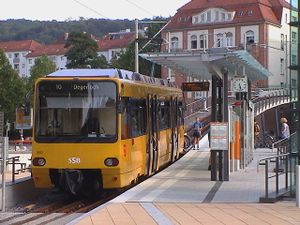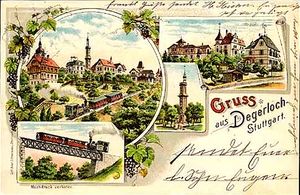Rack Railway Stuttgart
The Stuttgart Rack Railway (Zahnradbahn in German) is a rack railway in Stuttgart, Germany. It is the only urban rack railway in Germany and it is powered by electricity.
Affectionately called "Zacke" by the residents of Stuttgart, the line was opened on August 23, 1884. It connects the urban districts of Stuttgart South (Marienplatz) and Degerloch (Albplatz). The route runs along the "Alte Weinsteige", which was the historical main route to the "Filder" towns until the more comfortable "Neue Weinsteige" was built in 1826.
The 2.2 km route climbs a height of 205m (from 260m to 465m AMSL). The maximum incline on the route amounts to 17.5% (between Liststraße and Pfaffenweg). On the branch to the depot of the (old) rack railway yard, the maximum is 20.0%. Between Haltestellen Pfaffenweg and Wielandshöhe, two stops on the line, one has a wonderful view over Stuttgart's city center.
The rack railway is integrated with the metropolitan railway network of the "Stuttgarter Straßenbahnen AG" (Stuttgart streetcars) as line 10.
The Stuttgart Cable Car leads to the forest cemetery as line 20.
History
- 23 August 1884 saw the opening of the rack railway Stuttgart - Degerloch as the first route of the Filderbahn as a narrow-gauge (1 m (3 ft 33⁄8 in)) steam-operated railway with a Riggenbach system. The Filderbahn society operated the route from the Stuttgart station to the Degerloch station.
- 1902 saw the electrification of the rack railway as well as the adhesion routes Degerloch - Hohenheim and Möhringen - Vaihingen. The electrical start-up on the rack railway route however was delayed by two years due to technical problems.
- 1903 saw the relocation of the passing track from Haigst to Wielandshöhe.
- 1904 Start-up of the electrical operation on the rack railway, steam operation became limited to Sunday excursions.
- 1918 Two additional steam engines were taken over second-hand from the Swiss Brünigbahn for steam operation which increased due to war conditions.
- 1920 The Filderbahn was taken over by the city Stuttgart, and its management was transferred to the Stuttgarter Straßenbahnen AG (Stuttgart streetcars).
- 1921 Steam operation finally ceased.
- 1926 All passenger vehicles of the rack railway and Filderbahn were repainted with lacquer to match the SSB livery. However, in order to distinguish the SSB owned vehicles from the Filderbahn owned vehicles, the latter provisionally kept an "F" before its vehicle identification number.
- 1934 The Filderbahn, as well as the rack railway, became the property of the Stuttgarter Straßenbahnen AG (Stuttgart streetcars).
- 1935 to be translated from the original German language article.
- 1936 saw the relocation of the rack railway's Stuttgart terminal station from the valley to the Marienplatz for better transfers to the streetcar.
- 1937 Motor coach 103 was the first vehicle constructed completely out of steel to be delivered to the SSB.
- 1950 to be translated
- 1954 to be translated
- 1956 Transfer of (a) trailer(s) from the Filderbahn to the rack railway in order to handle the increased student traffic, this was however extremely rarely done and then only until 1965 when this practice was discontinued.
- 1965 Replacement of the old cast iron bridge (commonly called "the Turkish bridge because its fabricator, Maschinenfabrik Esslingen, originally intended to deliver the bridge to Turkey.) over the Neue Weinsteige by today's reinforced concrete bridge.
- 1971 As a result of the transformation of the track layout of Marienplatz and of the u-Haltestellenbaus the then double-tracked Valley Station at Marienplatz was replaced by a single-tracked station, half of which is located on the bridge across a water reservoir (filled later).
- 1974 to be translated
- 1977 As a result of the rebuilding of the rack railway's Degerlocher Station, the connecting track to the adhesion railway was eliminated and the rack railway became an isolated operation in the SSB network.
- 1978 to be translated
- 1980 to be translated
- 1982 Introduction of the modern ZT4 motor coaches in the metropolitan railway design. Exploring the possibility of the transportation of bicycles on the steep stretch in a demonstration wagon especially designed by the company.
- 1984 Celebration of the one hundredth-year and the educational last run on the traditional rack railway route by the still operational the motor coach 104 and the demonstration car 120.
- 1989 Replacement of the one time swinging leaf doors on the ZT4 by the appropriate external swing out doors on the DT8.
- 1992 Set up of the sale of display car 117 (year of construction: 1896) to the Härtsfeld-Museumsbahn (HMB) in Neresheim. Until then it was displayed by a private collector as a monument. The museum uses it today as narrow gauge passenger vehicle on its own track.
- 1994 Route extension on the mountain side to the Albplatz (Albstrasse?) in order to provide better connection with the metropolitan railway.
- 2002 Reopening of the rebuilt terminal and the bridge at the completely transformed Marienplatz (6 December).
- 2004 To be translated
See also
External links
| Wikimedia Commons has media related to: Rack Railway Stuttgart |



